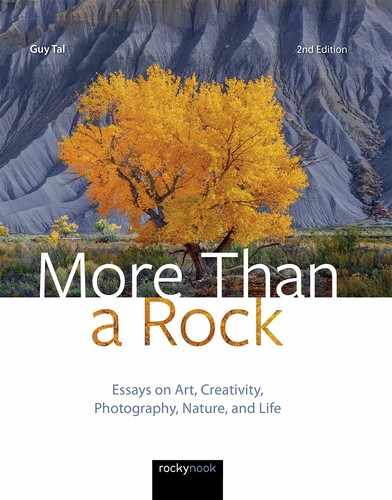Rethinking Visualization31
I now measure my growth as a photographer in terms of the degrees to which I am aware of, have developed my sense of, and have the skills to symbolize visually the four-dimensional structure of the universe.
—Wynn Bullock
In my workshops, I teach a framework for creative photography consisting of six phases: concept, visualization, composition, capture, processing, and presentation.
The premise for the framework is that all images begin with a concept: a nebulous, amorphous “trigger” that sets the creative wheels in motion. The concept may be a thought, an emotion, a response, or a sensation that the artist experiences and wishes to express in the finished work. The concept has no form, color, or other physical characteristics. It is the thing the image is about—an intuitive recognition of something worthy of further exploration, development, and expression. Once experienced, the artist’s task is to transform the shapeless, abstract concept into a tangible image.
Within this framework, visualization—the ability to imagine, to see in the “mind’s eye,” the finished outcome before choosing and applying specific tools and techniques—is the mental process of selecting the best way to express a concept using the visual elements and tools available. Visualization requires not only knowledge of the tools and limitations of photography, but also a keen understanding of visual perception—how the arrangement of colors, tonality (values), shapes, patterns, textures, and lines can combine to serve as visual metaphors, or equivalents, for emotions, tension, and meaning.
Visualization is not the same as vision. Vision consists of perceiving light reflected off objects; visualization is projecting the artist’s thoughts and feelings onto objects. Vision is about what there is; visualization is about what could be. Vision happens; visualization makes happen. Vision is about what things are; visualization is about what things mean.
Think of the artist as having the task of bridging two worlds: an inner world of feelings, notions, sensibilities, ideas, and abstractions available only to them; and an outer world consisting of literal objects, perceptible by physiological senses, that can be shared with others. Visualization is the process of facilitating the transition from one world to the other.
Certainly, there is no way to make the transformation from idea to object without a degree of craftsmanship and skilled application of tools; however, understanding visualization also serves to illustrate the role of such tools and skills in the creative process. Instinct, awareness, knowledge, and imagination give rise to a concept; visualization transforms the concept into an image in the mind of the photographer; equipment and technique make the image tangible.

